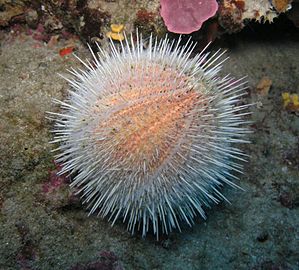Echinacea (animal)
The Echinacea are a superorder of sea urchins. They are distinguished by the presence of a rigid test, with ten buccal plates around the mouth, and solid spines. Unlike some other sea urchins, they also possess gills. The group is a large one, with species found worldwide.
| Echinacea | |
|---|---|
 | |
| Echinus melo | |
| Scientific classification | |
| Kingdom: | Animalia |
| Phylum: | Echinodermata |
| Class: | Echinoidea |
| Superorder: | Echinacea Claus, 1876 |
| Orders | |
|
(See text) | |
Echinacea are part of Animalia (kingdom), Echinodermata (phylum), Echinozoa (subphylum), Echinoidea (class), Euechinoidea (subclass), Carinacea (infraclass).
Child taxa
According to World Register of Marine Species:[1]
- Order Arbacioida (Gregory, 1900) -- 1 family and 2 fossiles
- Order Camarodonta (Jackson, 1912)
- Infraorder Echinidea (Kroh & Smith, 2010) -- 5 families
- Infraorder Temnopleuridea (Kroh & Smith, 2010) -- 2 families and 2 fossiles
- Order Stomopneustoida (Kroh & Smith, 2010) -- 2 families and 1 fossile
- Family Glyphopneustidae Smith & Wright, 1993 †
.jpg)
Temnopleurus toreumaticus,
a Temnopleuridea
Stomopneustes variolaris,
a Stomopneustoida
gollark: Which won't necessarily go faster just because you can write a few times more.
gollark: People actually spreading your content, quite possibly?
gollark: I don't disagree. However, you can already *do that* and I don't think the main limitation to fake news is just how fast/cheaply you can generate text.
gollark: Unicorns are a strong enough claim to prompt further checking. Language models passed the point where the output would seem plausible to a human who wasn't concentrating ages ago.
gollark: It's not an orders of magnitude improvement as you seem to be saying.
References
- "Echinacea WoRMS taxon details". World Register of Marine Species. Retrieved 29 July 2014.
- Barnes, Robert D. (1982). Invertebrate Zoology. Philadelphia, PA: Holt-Saunders International. p. 980. ISBN 0-03-056747-5.
- Kroh, A.; Smith, A.B. (2010). "The phylogeny and classification of post-Palaeozoic echinoids". Journal of Systematic Palaeontology. 8 (2): 147–212. doi:10.1080/14772011003603556.
This article is issued from Wikipedia. The text is licensed under Creative Commons - Attribution - Sharealike. Additional terms may apply for the media files.